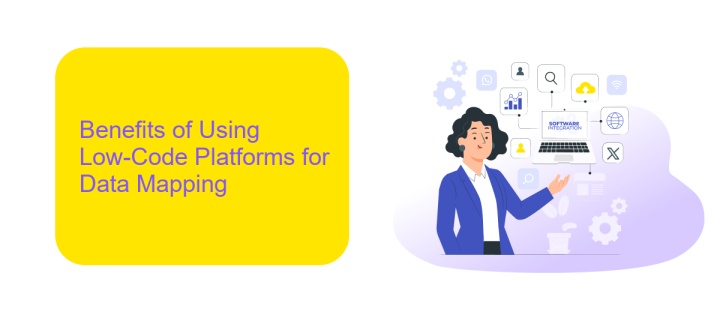Low-Code Data Mapping
In today's rapidly evolving digital landscape, businesses are constantly seeking ways to streamline operations and enhance efficiency. Low-code data mapping emerges as a powerful solution, enabling organizations to simplify the integration and transformation of data across various systems without extensive coding knowledge. By leveraging intuitive interfaces and automated processes, low-code platforms empower users to efficiently manage data workflows, fostering innovation and agility in data-driven decision-making.
Introduction to Low-Code Data Mapping
Low-code data mapping is revolutionizing the way organizations handle data integration and transformation. By minimizing the need for extensive coding, low-code platforms empower users to design, implement, and manage data flows with greater efficiency and less technical expertise. This approach democratizes data management, enabling business users and IT professionals alike to collaborate and innovate more effectively.
- Streamlined development processes reduce time-to-market for data-driven solutions.
- Enhanced accessibility allows non-developers to engage in data mapping tasks.
- Improved flexibility and scalability accommodate evolving business needs.
- Cost-effective solutions lower the barrier to entry for small and medium enterprises.
As organizations increasingly rely on data to drive decision-making, low-code data mapping offers a compelling solution to streamline operations and enhance productivity. By reducing the complexity traditionally associated with data integration, these platforms foster a more agile and responsive business environment. As a result, companies can focus on strategic initiatives and innovation, leveraging data as a competitive advantage.
Benefits of Using Low-Code Platforms for Data Mapping

Low-code platforms for data mapping offer a range of benefits that streamline and simplify the integration process. One of the primary advantages is the significant reduction in development time. By providing pre-built components and intuitive interfaces, these platforms allow users to quickly configure data mappings without extensive coding knowledge. This accelerates the deployment of data integration solutions, enabling businesses to respond swiftly to changing data requirements and market dynamics.
Additionally, low-code platforms enhance collaboration between IT and business teams. With user-friendly tools, stakeholders from various departments can actively participate in the data mapping process, ensuring that the final solutions align closely with business needs. Platforms like ApiX-Drive further enhance this experience by offering seamless integration capabilities, allowing users to connect diverse applications effortlessly. This not only reduces dependency on specialized IT resources but also empowers organizations to maintain and update their data integration solutions with ease, ensuring continuous alignment with evolving business objectives.
Key Features of Effective Low-Code Data Mapping Tools

Effective low-code data mapping tools are essential for organizations looking to streamline their data integration processes. These tools simplify complex data mapping tasks, allowing users to connect disparate data sources without extensive coding knowledge. By leveraging intuitive interfaces and automation capabilities, businesses can enhance productivity and reduce errors in data management.
1. **User-Friendly Interface**: A visual drag-and-drop interface enables users to easily map data fields between different systems, minimizing the need for technical expertise.
2. **Pre-built Connectors**: These tools often include a library of pre-built connectors for popular applications and databases, facilitating quick integration.
3. **Real-Time Data Processing**: Effective tools support real-time data processing, ensuring that data is always up-to-date and accurate.
4. **Scalability**: As data volumes grow, the tool should scale seamlessly to accommodate increased demand without compromising performance.
5. **Robust Error Handling**: Comprehensive error detection and handling mechanisms help maintain data integrity and reliability.
Incorporating these key features into low-code data mapping tools empowers organizations to efficiently manage their data ecosystems. By reducing dependency on IT resources, businesses can focus on strategic initiatives, driving innovation and growth. The right tool not only enhances data accuracy but also accelerates decision-making processes across the enterprise.
Use Cases and Examples of Low-Code Data Mapping

Low-code data mapping is revolutionizing how businesses handle data integration and transformation. By simplifying complex processes, it enables users with minimal coding skills to efficiently map data between diverse systems. This approach is particularly beneficial for organizations aiming to streamline operations and reduce dependency on IT departments.
One of the primary use cases of low-code data mapping is in data migration projects. Companies often need to transfer data from legacy systems to modern platforms, and low-code tools facilitate this by providing intuitive interfaces. Another significant application is in real-time data synchronization, which ensures that different systems within an organization are consistently updated with the latest information.
- Automating data integration between CRM and ERP systems.
- Streamlining ETL (Extract, Transform, Load) processes for data warehouses.
- Facilitating API integrations for seamless communication between applications.
- Enabling non-technical users to customize data workflows.
By leveraging low-code platforms, businesses can achieve faster deployment times and reduce costs associated with traditional data mapping methods. This empowers teams to focus on strategic initiatives rather than getting bogged down by technical challenges, ultimately enhancing productivity and driving innovation.


Choosing the Right Low-Code Data Mapping Solution
When selecting a low-code data mapping solution, it's crucial to evaluate its compatibility with your existing systems and data sources. Look for a platform that offers a wide range of integration options and supports various data formats to ensure seamless connectivity. The solution should also provide an intuitive interface that empowers users with minimal technical expertise to design and deploy data mappings effectively. Consider the scalability of the tool to accommodate growing data needs and its ability to handle complex transformations without compromising performance.
Additionally, assess the solution's support and documentation to facilitate a smooth implementation process. Services like ApiX-Drive can be instrumental in this regard, offering robust integration capabilities and user-friendly interfaces that simplify the setup of data connections. Evaluate the cost-effectiveness of the solution, ensuring it aligns with your budget constraints while delivering the necessary features. Ultimately, the right low-code data mapping tool should enhance productivity, reduce manual intervention, and support your organization's data strategy efficiently.
FAQ
What is Low-Code Data Mapping?
How does Low-Code Data Mapping benefit businesses?
Can Low-Code Data Mapping handle complex data transformations?
What are common use cases for Low-Code Data Mapping?
How can I start using Low-Code Data Mapping tools?
Strive to take your business to the next level, achieve your goals faster and more efficiently? Apix-Drive is your reliable assistant for these tasks. An online service and application connector will help you automate key business processes and get rid of the routine. You and your employees will free up time for important core tasks. Try Apix-Drive features for free to see the effectiveness of the online connector for yourself.

